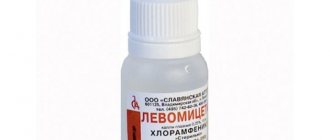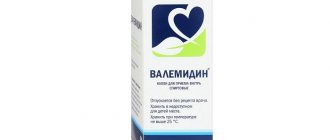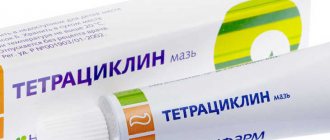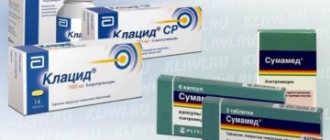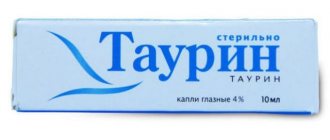Levomycetin is an antibacterial agent based on chloramphenicol from the amphenicol group. The drug has a wide spectrum of activity against gram-positive, gram-negative bacteria, and some large viruses. It is produced in various forms of release, including drops, tablets and capsules, ointment, solution.
Levomycetin is effective, but toxic and often causes severe adverse reactions when taken orally. For this reason, Levomycetin is recommended to be used only for medical reasons. When applied topically, the risk of complications is lower. Patients will be interested in knowing the cost of different dosage forms of the drug, studying reviews about it and knowing what medications can replace Levomycetin. Instructions for use with indications and contraindications are also presented below.
Composition and release forms
There are 5 dosage forms of Levomycetin:
- pills;
- capsules;
- eye drops;
- liniment (ointment);
- solution.
They differ in composition, but their mechanism of action is the same.
The main component of all forms of Levomycetin is chloramphenicol. This antibiotic has a wide spectrum of action and is used to treat severe infections (typhoid fever, dysentery, meningococcal infection) in humans and animals. This substance prevents the proliferation of pathogenic microbes and promotes their death.
Levomecitin tablets contain the following components:
- chloramphenicol (250 or 500 mg);
- potato starch;
- polyvinylpyrrolidone;
- calcium stearate.
In appearance, these are white or slightly yellowish tablets; they are round, flat-cylindrical, with a chamfer along the edges and a dividing line in the middle.
Levomycetin tablets have a systemic effect on the body together with Levomycetin capsules . The latter, in addition to chlorampheniol (250 mg), contain the following substances:
- powdered sugar;
- calcium stearate;
- potato starch;
- gelatin;
- titanium dioxide.
Capsules in a gelatin shell are white.
Levomycetin eye drops 0.25%, composition:
- chloramphenicol (2.5 mg);
- boric acid;
- purified water.
Levomycetin drops look like a clear or slightly colored solution. Drops are sold in bottles of 5 or 10 ml.
Levomycetin ointment , unlike other dosage forms, contains 2 active substances: chloramphenicol and methyluracil.
1 g of the product contains 7.5 mg of the first substance and 40 mg of the second. The composition is supplemented with polyethylene glycol 400 and polyethylene glycol 1500. The trade name of the ointment is Levomekol . In appearance, it is a homogeneous mass of white or slightly yellowish tint with a slight characteristic aroma.
1.3% alcohol solution
- chloramphenicol (1.3 g);
- ethyl alcohol (70%);
- purified water.
This colorless liquid smells like alcohol. It is packaged in 25 ml and 40 ml bottles.
What does the medicine "Levomycetin" (tablets) help with?
This drug is a broad-spectrum antibiotic. In terms of its composition, it is classified as bacteriostatic. This suggests that the drug not only suppresses the action of pathogenic microorganisms, but also inhibits their division and growth at the cellular level. Thus, the composition of the product blocks protein synthesis. As a result, the microbe dies.
In what cases is the drug "Levomycetin" prescribed? What do pills help with? Most often the medicine is prescribed in the following cases:
- for pathologies developing in the urinary system;
- during dysentery and pneumonia;
- for the treatment of genital tract infections (for example, chlamydia);
- for brucellosis and tularemia;
- for inflammatory eye diseases;
- during inguinal lymphogranuloma and psittacosis;
- for the treatment of purulent diseases (otitis, peritonitis, skin infections);
- with inflammation of the meninges;
- during the occurrence of abdominal infections (typhoid, paratyphoid);
- for the treatment of salmonellosis and toxoplasmosis;
- during diarrhea, and so on.
If you ask about the drug “Levomycetin” (the tablets help), then every second person will say that the medicine treats diarrhea and poisoning. However, this is not entirely correct. If the pathology is not caused by a bacterial infection, then the remedy may be completely powerless. In some cases, diarrhea is the result of a viral infection. In this case, the use of the drug is inappropriate.
Effect of the drug
Levomycetin has a pronounced antibacterial effect. The drug stops the proliferation of bacteria, prevents this process, and destroys pathogenic microorganisms. Chloramphenicol is active against microbes that are at rest and those that actively reproduce. The main component affects intracellular pathogens.
Infectious agents sensitive to the main component of Levomycetin slowly get used to its action. Cross-resistance to Levomycetin and other antibiotics rarely occurs.
Those subtypes of bacteria that remain resistant to Penicillin, Streptomycin, and antibiotics from the sulfonamide group are sensitive to chloramphinecol. However, Levomycetin has little effect on fungi and protozoa. The drug in the form of an ointment, in addition to the antibacterial effect, exhibits anti-inflammatory, reparative (restoration of damaged tissue) effects. Methyluracil accelerates cell regeneration, then wounds heal faster. Polyethylene glycol 1500 accelerates the removal of inflammatory exudate that accumulates at the bottom of the wound. And polyethylene glycol 400 enhances the effect of the main component, acting as its conductor into damaged tissues. As a result, the source of infection is cleared of purulent-necrotic contents, and swelling disappears faster.
Pharmacokinetics and pharmacodynamics
The antimicrobial effect of the drug is based on its ability to inhibit protein synthesis in the microbial cell.
Chloramphenicol does not disrupt the formation of amino acids, but stops the formation of a polypeptide chain from them. This occurs due to the inhibition of enzymes that catalyze the formation of peptide bonds in the ribosomal protein synthesis system.
Levomycetin stops the reproduction and destroys most pathogenic microorganisms: meningococci, gonococci, streptococci, staphylococci, Haemophilus influenzae and Escherichia coli, salmonella, spirochetes, etc. The drug has a detrimental effect on large viruses. It has a weak effect on Pseudomonas aeruginosa, acid-fast bacteria, protozoa, and clostridia.
When used internally (tablets and capsules), the main component is quickly and almost completely (90%) absorbed into the blood through the mucous membranes of the gastrointestinal tract. Its maximum content in the bloodstream is achieved after 1 – 3 hours.
The therapeutic effect lasts about 5 hours. Binds to blood plasma by 50–60%, and in newborns by 32%. The components can penetrate the placenta and the BBB (blood-brain barrier) and are excreted in breast milk.
The highest content of the main component Levomycetin when taking tablets is in the liver and kidneys. For example, bile contains about 30% of the dose received. The maximum concentration of the main substance in the cerebrospinal fluid is observed 4 - 5 hours after administration and reaches 21 - 89% (depending on the state of the meninges - non-inflamed or inflamed).
About 90% of the components of the tablets are processed by the liver. In the intestine, chloramphenicol is hydrolyzed by intestinal bacteria, resulting in the formation of inactive metabolites.
Levomycetin tablets are excreted from the body throughout the day. About 90% of the drug is found in urine, only 1–3% in feces.
The concentration of the main component is halved in adults after 1.5 - 3.5 hours, in case of impaired renal function - after 3 - 11 hours. The half-life in children under 16 years of age is from 3 to 6.5 hours, in newborns up to 2 days – from 24 hours, and in infants from 10 to 16 days after birth – 10 hours.
How do Levomycetin drops work? When drops are instilled into the eyes, the active substance is found in the cornea, aqueous humor, iris, and vitreous body. The active component of eye drops is absent in the lens.
Levomycetin ointment acts locally, a small part of the drug penetrates the mucous membranes. The therapeutic effect is observed within 20 – 24 hours.
Levomycetin alcohol solution penetrates poorly through the skin and mucous membranes. The intensity of the antimicrobial action depends on the area of the affected area and the amount of pus. The therapeutic effect lasts from 6 to 12 hours, then the product is applied again.
Indications for use
Doctors use Levomycetin to treat severe infections that other antibiotics cannot treat or the patient has contraindications to them. The drug is included in the treatment regimen only after laboratory tests have been carried out and the strain of microorganisms that caused the disease has been determined.
Levomycetin tablets and capsules are indicated in the following cases:
- brain abscess (accumulation of pus);
- typhoid fever;
- paratyphoid (damage to the intestines and its lymphatic system);
- intestinal infections caused by salmonella, shigella, brucella;
- tularemia (damage to lymph nodes, skin, sometimes eyes, pharynx, lungs);
- a group of diseases that provoke rickettsia (coxiellosis, typhus, trachoma, mountain fever, etc.);
- infection caused by meningococci;
- psittacosis;
- lymphogranuloma venereum;
- infections that cause chlamydia;
- intestinal yersiniosis;
- ehrlichiosis (an infection caused by ticks that carry ehrlichia bacteria);
- urinary system infections;
- purulent complications of wound infections;
- pneumonia;
- purulent inflammation of the peritoneum;
- biliary tract infections;
- purulent otitis.
Levomycetin eye drops are prescribed in the following cases:
- inflammation of the conjunctiva;
- blepharitis (inflammation of the edges of the eyelids);
- inflammation of the cornea of the eye;
- blepharoconjunctivitis;
- keratoconjunctivitis.
Levomycetin ointment is used to treat purulent wounds infected with various bacteria. It is effective at the initial stage of the wound process, and in the formation of trophic ulcers. The drug helps treat bedsores, infected burns, boils (abscesses caused by staphylococci) or carbuncles (clusters of boils).
An alcohol solution of Levomycetin is used to treat abrasions, scratches, insect bites, as well as at stage 2 of the wound process, which is characterized by the absence of pus and areas of tissue death (necrosis). It is indicated for purulent-inflammatory processes of the skin, the presence of trophic ulcers and burns of 2–3 degrees.
Contraindications
Levomycetin has categorical and relative contraindications. In the first case, the drug must not be used to treat an infection, and in the second, therapy with its use must be supervised by a doctor.
Levomycetin is strictly prohibited for use in the following cases:
- hypersensitivity to the main component or other components of the drug;
- depression of hematopoiesis (suppression of bone marrow hematopoiesis);
- acute intermittent porphyria;
- hereditary decrease in the activity of glucose-6-phosphate dehydrogenase (a special enzyme of erythrocytes (red blood cells));
- functional failure of the liver and kidneys;
- skin diseases, for example, psoriasis, eczema, fungal infections;
- period of gestation or breastfeeding.
In all the above cases, it is better to replace Levomycetin with another drug. Patients under 3 years of age and weighing less than 20 kg can take tablets or capsules only under the supervision of a physician. This restriction applies to people with cancer who have previously taken cytotoxic drugs or undergone radiation therapy. The drug should be taken with caution by persons with diseases of the cardiovascular system or a tendency to allergic reactions. It is necessary to reduce the dose of the drug if liver or kidney function is impaired.
You cannot wear lenses or use Levomycetin drops. The lenses can be put on a few days after the end of the course. Before using drops, it is better to consult a doctor.
Side effects
The following diseases may develop in the blood system:
- leukopenia (decrease in the number of leukocytes per unit volume of blood);
- thrombocytopenia (decreased number of platelets in the blood);
- reticulocytopenia (reduced content of reticulocytes in peripheral blood);
- decrease in hemoglobin level in the blood;
- cytoplasmic vacuolization of early erythrocyte forms;
- aplastic anemia (a special group of diseases of the blood system, characterized by a decrease in the number of all blood cells).
From the gastrointestinal tract the following is observed:
- nausea;
- vomit;
- diarrhea;
- flatulence;
- inflammation of the tongue, manifested as a result of injury, exposure to pathogenic microorganisms (glossitis);
- damage to the oral mucosa (stomatitis);
- disturbance of intestinal microflora;
- dysbiosis (a condition in which the composition of microorganisms inhabiting the intestines changes , which leads to disruption of the gastrointestinal tract);
- fungal diseases.
The following diseases may occur in the central nervous system:
- visual impairment;
- visual hallucinations;
- auditory hallucinations;
- peripheral neuritis (inflammatory disease of the peripheral nerves);
- inflammation of the optic nerve;
- migraine;
- depression;
- encephalopathy (non-inflammatory diseases of the brain).
Possible allergic reactions:
- skin rash;
- angioedema;
- feverish conditions;
- anaphylactic shock (an acute allergic reaction that occurs due to human contact with substances).
Children from one to three years old are most susceptible to them.
Contraindications
The drug should not be used if:
- inhibition of the blood system;
- individual intolerance to the medication;
- skin diseases;
- during pregnancy and lactation.
Important!
Should not be used by children under one year of age.
The drug Levomycetin can be used only after the permission of the attending physician . Before using the medication, you must be tested for reaction to chloramphenicol and amphenicol. It should be used with special caution by people with cardiovascular diseases, as well as patients prone to allergic reactions.
For the treatment of children under three years of age, the drug should be used only as a last resort and with extreme caution.
Instructions for use
Levomycetin is taken in different ways. The method of application, dose and frequency of use depend on the dosage form of Levomycetin and other factors (diagnosis and characteristics of the body). The attending physician will tell the patient how to use Levomycetin tablets, capsules, eye drops, ointment and solution.
Solid medicinal forms of Levomycetin for internal use are used half an hour before meals. The tablet or capsule is swallowed whole with water.
The dosage of Levomycetin tablets or capsules is determined by the doctor individually. The standard dose for adult patients is 250 to 500 mg three or four times a day. The daily dose of the medicine should not exceed 2000 mg.
For severe infections, when the patient is being treated in an inpatient department, the daily dose can be increased to 3000–4000 mg. This portion of the medicine should be divided into 3-4 equal portions. In this case, the doctor must constantly monitor the patient’s condition, regularly evaluate important blood parameters and kidney function using special studies.
If a person experiences nausea and/or vomiting when taking tablets or capsules, then it is better to drink Levomycetin an hour after a meal. This will reduce the risk of negative reactions and alleviate the patient’s condition.
The dosage of Levomycetin tablets for children depends on their age. At an early age, it is determined depending on the child’s weight.
It is important to complete the full therapeutic course to destroy all pathogenic microorganisms. On average, Levomycetin is taken from 7 to 10 days. If the patient tolerates the medication normally, then in severe forms of infection, treatment is extended to 14 days. It is not recommended to take Levomycetin again.
Levomycetin drops are instilled into the conjunctival cavity, 1 in each eye. The frequency of application of drops is 3 or 4 times a day at equal intervals. Drops should not be used for more than 3 days without the knowledge of the attending physician. In general, the therapeutic course of drops lasts no longer than 5 days.
Levomycetin drops - original instructions for use
Levomikol ointment is applied to gauze napkins, they are fixed on the wound with a plaster. The agent can be injected into the purulent cavities with a syringe through a drainage tube. But first the mass must be heated to 36°C. The course of treatment lasts 4 days, but no more than 5–7 days. After this time, the ointment must be replaced with drugs that restore the integrity of damaged skin areas. With prolonged use, osmotic stress (cell damage) is possible.
An alcohol solution of Levomycetin is applied to gauze swabs, they are applied to the affected area or to the wound itself. The affected area is bandaged on top, and when applying a compress, compress paper is placed under the dressing material. The procedure is carried out at intervals of 1 - 3 days, sometimes with an interval of 4 - 5 days.
Directions for use and doses
How to take chloramphenicol tablets? The drug is taken half an hour before meals . The required dosage is selected by a specialist, taking into account the course of the disease. Course duration is from 1 week to 10 days. In the absence of negative consequences and if the substance is easily tolerated, the duration of therapy can be increased to 2 weeks.
Adults are prescribed 1-2 tablets of 0.25 g 3-4 times a day. The maximum dose should not exceed 2 g per day.
Particularly severe cases require the use of 4 g of medication in 3-4 doses. In this case, it is necessary to monitor the condition of the kidneys, liver, and blood composition.
Tablets are prescribed to children with caution, after consultation with a specialist.
Levomycetin for children is used based on the child’s body weight:
- at the age of up to 3 years – 10-15 mg per 1 kg;
- from 3 to 8 years – 0.15-2 g;
- over 8 years old – 0.2-0.3 g.
The drug is taken 3 to 4 times a day.
The powder from which the solution is made is used for intravenous and intramuscular use. In childhood, injections are made only into the muscle. To do this, the contents of the bottle must be dissolved in 2-3 ml of water. Injections are given at regular intervals.
The duration of therapy is determined by the attending physician.
To treat eye pathologies, the solution is dripped into the conjunctival area several times a day. The duration of treatment is from 5 days to 2 weeks.
The annotation for chloramphenicol indicates that vaginal suppositories must be inserted deep into the vagina while lying on your back three times a day. The maximum dose is 4 suppositories, the duration of therapy is 8-10 days. In some cases, the course of treatment is extended to 2 weeks.
Side effects
What side effects can Levomycetin cause? The instructions describe that in some cases Levomycetin can cause the following negative reactions:
- digestive disorders: burning behind the sternum, belching, flatulence, rumbling in the stomach, diarrhea, vomiting, irritation of the oral mucosa, disruption of the natural bacterial flora of the intestine;
- an abnormal decrease in reticulocytes (immature red blood cells), leukocytes, granulocytes, platelets, red blood cells in the blood, in rare cases, hypoplastic anemia develops (suppression of the hematopoietic function of the bone marrow), agranulocytosis (decreased number of leukocytes);
- psychomotor disturbances (tics, stupor, tremor, etc.), depression, blackouts, inflammation of peripheral nerves (decreased sensitivity, paresis, paralysis), optic neuritis, hallucinations, weakened hearing and vision, headache;
- allergic rash, redness, local swelling, nettle fever, Quincke's edema.
Other negative reactions include mycosis (fungal infection) based on a primary infection, collapse (sudden functional failure of the cardiovascular system, loss of consciousness, threat of death) in infants under 1 year of age. Also, after internal use, irritation of the penis and dysbiosis (disturbance of the normal microflora) of the vagina are possible. The list of possible negative reactions after taking Levomycetin is supplemented by paroxysmal nocturnal hemoglobinuria, the Jarisch-Herxheimer reaction (a shock-like state to certain antibiotics).
When using eye drops, the following negative reactions may occur:
- decreased visual acuity;
- severe pain in the eyes;
- fear of bright light;
- rash on the face and/or head;
- corneal clouding;
- sensation of a foreign body in the eye.
In such cases, it is necessary to visit an ophthalmologist, the doctor will advise how to proceed further, and may prescribe other drops.
Before using eye drops, you should inform your doctor about the following conditions:
- conjunctivitis;
- glaucoma;
- kratoconjunctivitis (sicca keratitis);
- eye surgery or laser therapy performed within the last 6 months;
- use of contact lenses.
One more point should be taken into account before using Levomycetin drops. The instructions for use indicate that the use of contact lenses is prohibited during their use. They can be put on only 1 – 2 days after the end of the course of therapy.
If adverse reactions occur after using any dosage form of Levomycetin, you should consult your doctor.
“Levomycetin tablets, what does this antibacterial medicine help with? The drug is an effective antibiotic that is used to treat infectious diseases. The medication is especially in demand in pediatric and ophthalmological practice. "Levomycetin" instructions for use recommends use for conjunctivitis, furunculosis, salmonellosis.
Release form and composition
The drug is supplied to the pharmacy in the form of:
- Eye drops 025%.
- An alcohol solution with a mass fraction of the active substance from 025% to 5%.
- Capsules and tablets 250 and 500 mg.
- Liniment 1% or 5%.
- Extended-release tablets 650 mg.
- trophic ulcers;
- wounds;
- cracked nipples;
- boils;
- purulent otitis (the auricle is treated with Levomycetin solution);
- bedsores;
- infectious skin lesions of a bacterial nature.
- salmonellosis;
- yersiniosis;
- infections of the urinary and biliary organs;
- ehrlichiosis;
- typhoid fever;
- trachoma;
- rickettsiosis;
- lymphogranuloma of the groin;
- chlamydia;
- paratyphoid;
- brucellosis;
- purulent wounds;
- tularemia;
- brain abscess;
- purulent peritonitis;
- dysentery;
- meningitis.
- keratitis;
- episcleritis;
- keratoconjunctivitis;
- scleritis;
- conjunctivitis;
- blepharitis.
- individual rejection of the active component and components of the drug;
- skin pathologies;
- eczema;
- depressed hematopoiesis;
- psoriasis;
- fungus on the skin;
- sore throat;
- acute respiratory infections;
- pregnancy;
- breastfeeding.
- leukopenia;
- blurred vision;
- hearing loss;
- nausea;
- thrombocytopenia;
- cardiovascular collapse;
- reticulocytopenia;
- allergies;
- confusion,
- diarrhea;
- decrease in hemoglobin;
- hallucination;
- vomiting;
- psychomotor disorders.
The active element of the drug "Levomycetin", from which tablets, drops and solution help with many infections, is chloramphenicol, which belongs to the category of antibiotics - amphenicols. The composition of the auxiliary components depends on the form of release of the drug and the manufacturer.
Pharmacological properties
The drug "Levomycetin" is an antibacterial agent with a wide range of applications. The active component has a detrimental effect on gram-positive and gram-negative bacteria, microorganisms that cause dysentery, typhoid fever, and meningitis. The medicine has bacteriostatic properties.
“Levomycetin tablets, for which reason they are used in various branches of medicine, help with diseases caused by spirochetes, chlamydia, brucella, hemophilus influenzae and other bacteria. The medication does not have the desired effect on protozoan microorganisms, clostridia, and Pseudomonas aeruginosa. Resistance to the antibiotic "Levomycetin" in bacteria develops slowly, while addiction to other drugs is not observed.
When using drops, the active substance accumulates in the iris, vitreous body, cornea, and the lens does not receive Levomycetin. The medication is well absorbed by the body when taken internally, concentrating maximum in the blood after 1-2 hours.
Solution, drops, tablets "Levomycetin": what does the medicine help with?
Indications for the use of alcohol solution and liniment are:
“Levomycetin tablets – for what
Capsules and tablets should be taken for:
What does Levomycetin drops help with?
Levomycetin eye drops are used to treat the following infectious pathologies caused by bacteria:
Contraindications
The instructions for use of the medicine "Levomycetin" prohibit its use for the following diseases and conditions:
The product should not be used together with barbiturates, sulfonamides, cytostatic drugs, Butamide; modifications of pyrazolone. The medicine "Levomycetin" quickly penetrates into mother's milk, from which it can be used during lactation.
Medicine "Levomycetin": instructions for use
Using Levomycetin solution and eye drops
To obtain a solution, the powder is diluted in 2-3 ml of injection water. The dosage and duration of therapy is determined by the doctor according to indications separately for each patient. Injections are given into a vein or muscle tissue. Levomycetin eye drops are injected into the conjunctiva 1 - 2 units 3-5 times a day. Treatment lasts 5-15 days.
How to take the pills
Levomycetin capsules and tablet form are taken orally 30 minutes before meals. Adult patients are prescribed 1-2 tablets 3-4 times a day. The daily volume of the medication reaches 2 g. In difficult cases, it is possible to take 4 g of the drug 4 times a day. In this case, medical monitoring of the functioning of the kidneys and liver, as well as blood composition, is necessary.
The duration of therapy depends on the indications and is about 7 - 10 days. If there are no adverse reactions, the medication can be taken for two weeks if necessary.
Instructions for use of Levomycetin for children
For children under 3 years of age, the one-time amount of the drug is determined by body weight: 15 mg per kg. Up to 8 years of age, children are given 150 mg 3-4 times a day. Children over 8 years old should take 025 g 3-4 times a day.
Side effects
The drug, when observed in therapeutic doses, is well tolerated by patients. In some cases, injections, Levomycetin tablets, reviews indicate this, can cause adverse reactions in the body, which are expressed as follows:
Analogs
"Levomycetin" can be replaced by the following antibiotics that have a similar mechanism of action: "Fluimucil", "Neomycin", "Gentamicin", "Baneocin", "Sintomycin", "Fucidin". The analogue “Levomycetin Actitab” is also popular. What does this drug help with?
The main indication for use is bacterial infection. Patients leave good reviews about the eye drops “Levomycentin-Acri”, -AKOS, -DIA.
Patient opinions
The main reviews of the solution and tablets "Levomycetin" related to the use of medication for acne. People who have used this acne remedy report that their skin cleared up within a couple of days. To combat acne, a mash is prepared for external use, which includes calendula tincture, Aspirin and Levomycetin.
Reviews are also left by positive patients about eye drops. They confirm the effectiveness of the product, noting its low price. Side effects are discussed in isolated cases.
Overdose
What reactions may occur if Levomycytin is taken incorrectly? The instructions for use state that if you increase the dosage on your own, serious negative reactions occur. The toxic concentration of chloramphenicol in the blood is 25 mcg/ml. With such indicators, aplastic anemia manifests itself, the level of platelets and leukocytes in the blood decreases, and the concentration of serum iron increases. An overdose is manifested by vomiting, discoloration of the skin in a gray-blue tint, a decrease in body temperature, respiratory failure, cardiovascular failure, and a decrease in the number of hematopoietic cells (hematopoietic depression). This condition occurs when the dosage is exceeded once.
Long-term use of Levomycetin in toxic doses increases the risk of “gray syndrome” in newborns and premature infants. This condition is manifested by vomiting, bloating, breathing problems, blue discoloration of the skin and mucous membranes. It is caused by the accumulation of chloramphenicol in the body; immature enzymes in the child’s liver cannot process the substance, so it has a toxic effect on the heart muscle. In the absence of therapy, gray syndrome is complemented by neurogenic shock, hypothermia (lower temperature), acidosis (lower pH).
According to statistics, 40% of children die from gray syndrome.
With prolonged toxic effects of Levomycetin, the risk of bleeding increases due to a decrease in the number of hematopoietic cells (depression of hematopoiesis) or disruption of the synthesis of vitamin K by intestinal microflora. If symptoms of overdose appear, you should immediately stop taking the drug and carry out symptomatic treatment. There is no antidote for chloramphenicol.
Interaction with other drugs
What interactions does Levomycetin exhibit with other drugs? The instructions for use describe that during the course of taking Levomycetin it is important not only to observe the dosage and frequency of administration, but also to know which medications it is not recommended to combine it with. Usually the treatment process is controlled by a doctor who draws up drug combinations. But it is advisable that the patient remember the list of drugs with which it is not recommended to combine Levomycetin:
- Medicines that inhibit hematopoiesis, for example, antimicrobial agents from the sulfonamide group, cytostatic drugs, pyrazolone derivatives. They disrupt metabolic processes in the liver, inhibit the functionality of the bone marrow, and during radiation therapy, this combination of medications increases the risk of adverse reactions.
- Products containing ethyl alcohol. In this case, the likelihood of developing a disulfiram-like reaction increases; it is manifested by chest pain, redness of the skin, tachycardia, nausea, vomiting, reflex cough, etc.
- Synthetic antidiabetic drugs. When combined with Levomycetin, metabolism in the liver is suppressed, the concentration of medicinal components in the blood increases, and as a result, their effect is enhanced.
- Erythromycin, Clindamycin, Lincomycin. When combined with Levomycetin, the effect of both drugs is weakened. This is because chloramphenicol displaces these antibiotics from their bound state or interferes with their binding.
- Penicillins and cephalsporins. This drug combination is undesirable, since Levomycetin reduces the antimicrobial effect of other antibiotics.
- Phenobarbital, Phenytoin, indirect anticoagulants. When taken together, Levomycetin slows down the metabolism of these drugs, then they are eliminated more slowly, and their concentration in the blood increases.
Levomycetin should not be combined with Cimetidine, Cycloserine, Ristomycin. The first and third drug combinations threaten hematotoxicity (impairment of the functions of blood cells or its composition) and neurotoxicity (adverse effects on the structure or function of the nervous system).
Use of Levomycetin
Levomycetin should be taken on time. Usually - half an hour before meals or an hour after (mainly for those patients who experience attacks of nausea in response to the medicine). Take the tablets with enough water; Chewing and crushing them is not recommended.
The doctor prescribes doses depending not only on the nature of the disease, but also on the age of the patient:
- children from 3 to 8 years old - 125 mg;
- children from 8 to 16 years old, 250 mg;
- adults: 1-2 tablets 250-500 mg.
For an adult, the maximum daily dose is 4000 mg, and it is necessary to monitor the patient's condition by monitoring the functioning of the kidneys and liver, as well as monitoring the chemical composition of the blood.
The drug is taken for 1-1.5 weeks 3-4 times a day. If no side effects are noted, the duration of the course can be increased to 2 weeks.
Contraindications for use
This medicine is not prescribed to patients with hypersensitivity to its components, or if there is sensitivity to substances such as thiamphenicol and azidamphenicol. Levomycetin is contraindicated in patients who have:
- dysfunction of hematopoiesis;
- liver diseases;
- kidney diseases;
- fungal skin diseases;
- psoriasis;
- eczema;
- porphyria;
- acute respiratory diseases (especially sore throat - after all, complications on the liver or kidneys are possible).
Some patients should take it with caution. This is, first of all:
- elderly people;
- those suffering from diseases of the cardiovascular system;
- prone to allergic reactions;
- performing potentially hazardous work.
It should be remembered that the drug is not intended to prevent infectious complications in case of surgery. Levomycetin is not prescribed to pregnant and lactating women, as well as children under 3 years of age.
Side effects and overdose
No matter what Levomycetin tablets are prescribed for, you should always remember about possible side effects. Among them may be:
- headache;
- confusion;
- hallucinations;
- disturbances in the functioning of the sense organs;
- indigestion;
- nausea and vomiting;
- disturbance of intestinal microflora;
- liver dysfunction;
- anemia and other diseases characterized by a decrease in the content of certain elements in the blood - up to the development of pancytopenia (decrease in the content of all elements);
- blood pressure disorders;
- acute vascular insufficiency (collapse);
- allergic reactions;
- increased body temperature;
- superinfection, etc.
As for an overdose, the patient may experience a variety of symptoms - from fatigue and general weakness to visual disturbances and changes in skin color. In some cases, collapse may occur. If an increased dose of medication has been taken, the patient's stomach is washed and enterosorbents are prescribed.
Compatibility of Levomycetin with other drugs
This drug cannot be combined with ristomycin, streptocide and other antibiotics, as this will lead to impaired hematopoiesis. A combination of a course of Levomycetin with radiation therapy leads to a similar result.
Levomycetin can enhance the effect of hypoglycemic drugs and reduce the effectiveness of some contraceptives or drugs containing iron, for example.
Its action is influenced by drugs such as phenobarbital, rifabutin or paracetamol. And cycloserine can increase its neurotoxicity. Penicillin, levorin or erythromycin in combination with Levomycetin may have a reducing effect on each other's effectiveness.
While taking Levomycetin, it is not recommended to drink alcoholic beverages, as this can lead to adverse consequences for the body.
Before using Levomycetin for anything, you should definitely consult a therapist. This is a strong antibiotic that can negatively affect the human body.
Levomycetin for children
Levomycetin tablets and capsules should not be taken by children under 3 years of age. Upon reaching this age, the drug is prescribed in the following dosage - from 10 to 15 mg/kg of total weight. At 3–8 years of age, a single dose reaches 150–200 mg of the active substance. Patients over 8 years of age can take 200–300 mg of the drug at a time. The frequency of taking the medicine is 3 or 4 times a day. Exceeding the indicated doses is strictly prohibited.
For severe infections, children are prescribed 75–100 mg/kg per day. In this case, the doctor should monitor the concentration of chloramphenicol in the blood.
Levomekol ointment should not be used to treat children under 3 years of age. Alcohol solution and drops of Levomycetin are indicated for use from 2 years.
Contraindications to the use of Levomycetin
The drug is strictly forbidden to be taken for the following diseases and conditions:
- hypersensitivity to the composition of Levomycetin, azidamphenicol, thiamphenicol;
- severe kidney and liver diseases;
- disruption of the hematopoietic system;
- lack of glucose-6-phosphate dehydrogenase;
- fungal skin infection, eczema, psoriasis;
- acute respiratory illnesses.
The medication is not prescribed during pregnancy, lactation and in children under 3 years of age.
Recommended video:
The medicine is used with extreme caution and under the supervision of specialists:
- in old age;
- for pathologies of the cardiovascular system;
- with a tendency to allergic manifestations.
When treating with Levomycetin, maximum care must be taken when operating vehicles and dangerous machinery.
During pregnancy and breastfeeding
The use of any dosage forms (including drops, ointment and solution) of Levomycetin during pregnancy or breastfeeding is contraindicated. This is due to the fact that the drug has not been studied in this group of patients.
The main component of Levomycetin penetrates the placenta. As a result of animal studies, it has been proven that chloramphenicol has an embryotoxic effect. This means that the substance, when it enters the mother’s body, causes pathological disturbances in the development of the fetus or its death. Then the child may experience congenital changes and diseases that are not associated with external manifestations, but cause severe functional disorders of important systems, for example, the central nervous system.
The toxic effects of Levomycetin can cause a tetratogenic effect. This means that the active component increases the risk of deformities in the fetus due to disruption of its development.
Levomycetin is prohibited for lactating women. This is due to the fact that the active component penetrates into breast milk and is passed on to the baby along with it. And this threatens severe adverse reactions in the baby.
During pregnancy and lactation, women can take Levomycetin only when absolutely necessary under the supervision of a doctor who will monitor the patient’s condition and, if necessary, reduce the dose or select a safer drug. Nursing mothers will have to stop breastfeeding and express milk during the course. After completion of therapy, lactation can be restored.
The danger is posed not only by the internal forms of the drug (tablets, capsules), but also by eye drops, ointment, and alcohol solution.
Levomycetin with alcohol
The instructions do not say that the combination of Levomycetin and ethyl alcohol is dangerous. In this case, the risk of seizures increases, and sometimes even death is possible. For this reason, you should not take Levomycetin and then drink alcohol. Even low-alcohol drinks can cause severe adverse reactions.
The fact is that chloramphenicol is processed in the liver under the influence of cytochromes of the P450 family and some other enzymes. Ethanol is converted in the same way. However, Levomycetin contains substances that prevent the formation of these enzymes. This has been proven by experiments in which patients took this drug for a long time or increased its dosage (under the supervision of a doctor).
The active ingredient Levomycetin with ethyl alcohol poisons the liver, and then other important systems of the body. With this combination, the risk of developing an antabuse effect increases. This is an acute intoxication of the body caused by inhibition of aldehyde dehydrogenase (an enzyme that accelerates the oxidation of aldehydes). Then acetaldehyde, which is a toxic poison, accumulates in the body. Normally, it is oxidized to safe acetic acid, but when Levomycetin is combined with alcohol, it is not. Therefore, this substance accumulates, causing the following symptoms:
- nausea, vomiting;
- dizziness;
- tremor;
- headache;
- excessive sweating;
- hypothermia.
Also, heart rate and breathing are often disturbed, the skin of the face turns red, chills are felt, and general weakness occurs.
Acetaldehyde disrupts metabolic processes in cells and organs by interacting with various enzymes in them. This toxin increases the content of acidic breakdown products of ethyl alcohol and its derivatives in the blood. That is, “blood acidification” occurs. This substance enhances lipid peroxidation and promotes the destruction of cell membranes. The combined effect of acetaldehyde and ethanol causes a hangover.
If the body is poisoned with aceteldehyde, you must call an ambulance. It is necessary to perform gastric lavage and symptomatic treatment.
For these reasons, it is prohibited to take Levomycetin and alcoholic beverages at the same time. Doctors clarify that you should not drink alcohol until chloramphenicol is completely eliminated from the body (and vice versa). Therefore, you should avoid alcoholic beverages during the treatment period.
special instructions
Since chloramphenicol is highly toxic, take internal and external forms of Levomycetin, incl. drops are not recommended without the knowledge of a doctor. You should not use an antibiotic to treat simple bacterial infections. It is prohibited to take the drug for the prevention of diseases whose pathogens are sensitive to the main component of Levomycetin.
It is important to follow the dosage of the drug prescribed by your doctor. It is also worth following his recommendations regarding the frequency and duration of taking the antibiotic. It is strictly forbidden to use more than 4 g of chloramphenicol per day. Otherwise, the risk of complications from the hematopoietic system increases. The consequences will be especially dire if the maximum dose of the drug is exceeded for a long time.
During the course of therapy, it is necessary to monitor the composition and quality of blood. For this purpose, blood tests are performed regularly.
It is strictly forbidden to drink alcoholic beverages (even low-alcohol ones) during the course of treatment with Levomycetin. Otherwise, the likelihood of acute intoxication of the body due to the accumulation of acetaldehyde in the blood increases sharply.
Pregnant and nursing mothers are prohibited from taking Levomycetin, since the effect of the drug on the fetus and newborns is unknown. After testing on animals, it was proven that the drug has a toxic effect. Fetuses and infants do not yet have enzymes that bind chloramphenicol. When it accumulates in a child’s body, the risk of gray syndrome increases, which often ends in death, so in such cases it is forbidden to take Levomycetin.
The instructions for use indicate that Levomycetin is prohibited for use for treatment during vaccination. During the course, it is necessary to constantly monitor the composition of peripheral blood.
Under the supervision of a physician, Levomycetin can be used by patients with diseases of the heart and blood vessels, liver, kidneys, predisposition to allergies, as well as people who have recently taken cytostatics or have undergone radiation therapy.
Shelf life, storage and sales conditions
Levomycetin tablets and capsules can be stored for 5 years.
The shelf life of Levomycetin drops for eyes is 2 years. After opening the bottle, the solution must be used for 4 weeks, after which it becomes unsuitable for treatment.
An alcohol solution of Levomycetin can be stored for 3 years. The ointment has the same shelf life.
Tablets and capsules are stored in a dark place at a temperature of about +25°C. There should be low humidity in this place, as the dosage form will become damp.
Levomycetin eye drops have the same storage conditions. After opening the bottle, it is recommended to move the drug to a place where the temperature does not exceed 15–20°C.
Levomycetin alcohol solution and ointment are also stored in a dark, dry place with an air temperature of no more than +25°C.
All dosage forms of Levomycetin should be kept away from children. After all, this medicine is dangerous for their body.
Tablets and capsules are available in pharmacies with a doctor's prescription. Levomycetin eye drops, ointment and alcohol solution can be purchased without a prescription. However, this does not mean that the medicine is safe, so you can take it after consulting a doctor.
Compound
The active substance of Levomycetin in all its forms is chloramphenicol - a substance that belongs to the amphenicol group of antibiotics.
Eye drops contain chloramphenicol at a concentration of 2.5 mg/ml.
Possible dosages of the active substance for capsules and tablets are 250 and 500 mg, for extended-release tablets - 650 mg (tablets have 2 layers - the outer layer contains 250 and the inner layer contains 400 mg of chloramphenicol).
An alcohol solution of Levomycetin is available in a concentration of 0.25; 1, 3 and 5%. Levomycetin ointment can have a concentration of 1 or 5%.
Drugs from different manufacturers have different compositions of auxiliary components.
All versions of the same product produced by pharmaceutical companies in post-Soviet countries differ slightly, since they use the same technology for producing chloramphenicol. Thus, Levomycetin DIA eye drops do not differ from the drops produced, for example, by the Belmedpreparaty company.
Analogs
If there are contraindications, the doctor can replace Levomycetin with drugs containing active substances with a similar mechanism of action:
- Phosforal Rompharm based on fosfomycin in the form of granules for the preparation of an oral (oral) solution. The drug is indicated for urinary tract infections that are caused by pathogenic microorganisms sensitive to the active component. The medicine is contraindicated if you are allergic to fosfomycin, have kidney failure, are under 12 years of age, etc.
- Uronormin-with fosfomycin. This powder for preparing a solution for internal use is prescribed for infectious and inflammatory diseases of the lower urinary tract. The drug is contraindicated for allergies, pregnancy and lactation.
- Monural also contains fosfomycin, which is effective against many gram-negative and gram-positive bacteria. The granules are mixed with water to prepare a solution for oral, intravenous or intramuscular administration. Monural is used to treat bacterial infections caused by fosfomycin-sensitive bacteria. The medicine is contraindicated if you are allergic to the active substance or are pregnant.
- Fosfomycin, based on the substance of the same name, is used to treat bacterial urinary tract infections. Granules should not be used if you are allergic to their components, have chronic renal failure, are breastfeeding, or are under the age of 5 years.
- Fosfomycin Esparma is also used to treat genitourinary infections. The powder cannot be used if you are allergic to its components, have kidney failure, are breastfeeding, etc.
These are group analogs that can only be prescribed by specialists.
Levomycetin instructions
This drug is used exclusively orally. The drug is made in the form of tablets that must be swallowed whole, without crushing them beforehand, simply with water. The best option would be to take the medication approximately 30 minutes before meals. There are isolated cases when Levomycetin tablets cause a feeling of nausea in the patient; only in this case, it is recommended to take the drug 1 hour after eating. Moreover, it is worth remembering that this drug must be taken consistently, at regular intervals, and these intervals themselves and the duration of administration must be discussed during a consultation with an experienced doctor.
Levomycetin indications
Indications for the use of the drug can be very extensive, since this drug is part of the group of antibiotic drugs, which means that chloramphenicol can quite actively fight against:
— All kinds of infectious and inflammatory diseases that were caused by microbes and bacteria sensitive to chloramphenicol.
- With long-term, chronic diseases of the biliary tract.
— Chlamydia, typhoid fever, rickettsiosis, paratyphoid fever, meningitis, shigellosis, purulent peritonitis, brucellosis, sepsis, pneumonia, and many other diseases in which other antimicrobial agents have proven to be ineffective.
Synonyms
This category includes drugs that have an identical active substance (chloramphenicol) and similar release forms. Synonyms of Levomycetin include:
- Levomycetin-DIA in the form of drops or eye ointment. The drug is indicated for eye infections caused by microorganisms sensitive to chloramphenicol. It is prohibited to use for allergies, applastic anemia, functional failure of the liver, kidneys, etc.
- Syntomycin in the form of an aerosol, liniment and solution is used to treat wounds, trophic ulcers, and 2nd - 3rd degree burns. It has the same contraindications as Levomycetin.
- Synthomycin liniment is prescribed for the treatment of ulcers, trophic ulcers, burns, and cracked nipples.
- Levomycetin Actitab in tablet form is indicated for urinary and biliary tract infections.
- D, L-Chloramphenicol is a liniment for the treatment of wounds, ulcers, and burns.
All these drugs contain chloramphenicol as a base, so their mechanism of action is no different. The decision to choose a similar drug is made by the attending physician.

